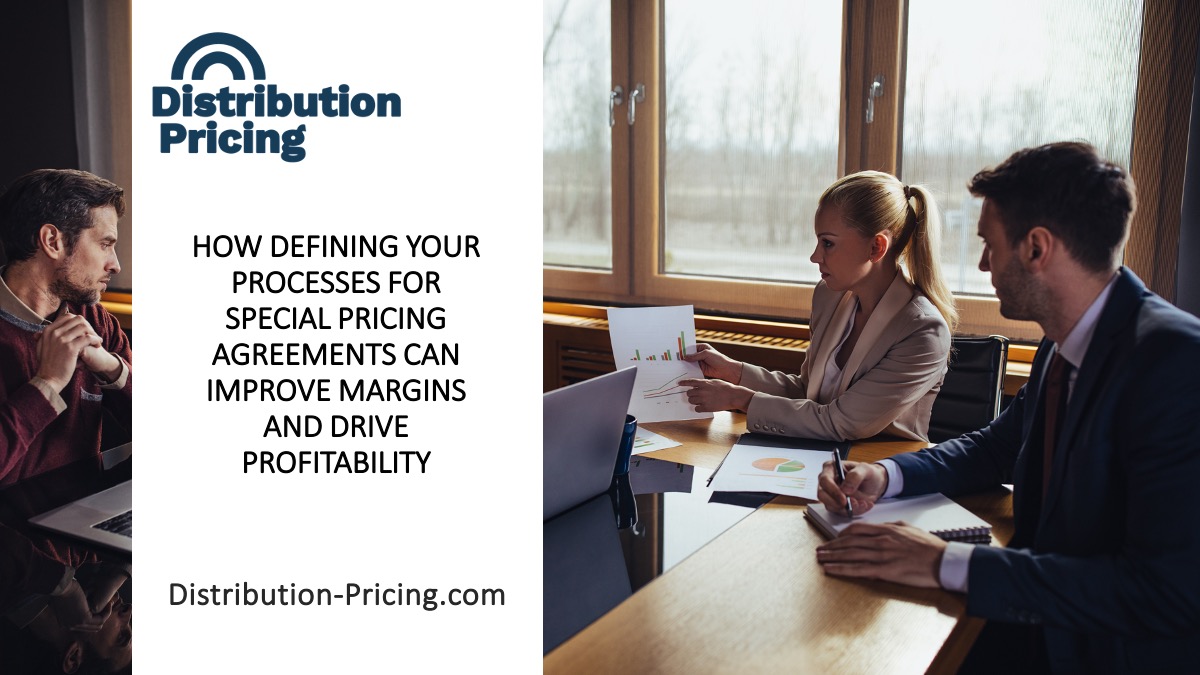Pricing is the battleground where wholesale distributors compete for profitability and market share. More distributors…

How Defining Your Processes for Special Pricing Agreements Can Improve Margins and Drive Profitability
Sometimes you need some extra help closing strategic customers. That’s where Special Pricing Agreements (SPAs) come into play. SPAs are a common vendor program that provide a special framework for offering exclusive pricing and incentives to strategic customers. Distributors collaborate with suppliers to create custom pricing arrangements that strengthen ties between manufacturers, distributors, and strategic customers.
SPAs also foster closer collaboration between manufacturers and distributors, aligning their sales and marketing strategies with strategic accounts. The distributor and supplier work together to negotiate these agreements to specific customers or market segments based on marketing goals to offer reduced pricing.
These arrangements make it easier for distributors to navigate economic turbulence with more stability and agility. They might help mitigate unexpected market changes like increased competition, rising costs or changes in customer demand. There are many situations where in-stock discounts and rebates do not provide the distributor with enough margin to secure certain orders. That’s where a special pricing agreement can help. Most importantly, they give distributors and manufacturers a structured way to work together to increase sales by supporting unique pricing strategies.
While there are many benefits to SPAs, they also come with their own set of challenges. So, it is critical that both manufacturers and distributors have tight processes and up-to-date data to ensure that the terms of each SPA align with their strategic goals.
SPA Processes
The SPA process is straightforward. A deal is negotiated between the vendor or manufacturer and the distributor, which details the terms for a unique pricing agreement. The distributor receives an order from a customer that qualifies for the special price. Following this, the distributor files a claim with the vendor or manufacturer to recoup the special discount. The vendor then processes this claim – usually as a type of chargeback although terms vary quite a bit — and the distributor logs the payment. Let’s explore the specific stages a Special Pricing Agreement (SPA) process might involve.

Identify the SPA Opportunity
The first step in the Special Pricing Agreement (SPA) process involves spotting a potential opportunity. This can be done by either the manufacturer or the distributor. The opportunity could emerge from various scenarios.
In one instance, offering a special price may clinch a sale that might otherwise be lost. For example, a customer might be considering multiple vendors, and a special price could tip the balance in favor of the manufacturer or distributor.
Alternatively, the opportunity could be a strategy to cultivate a long-term relationship with a customer. This is often the case with large clients or repeat customers where the margin hit taken by offering a special price can be offset by the volume or frequency of future orders.
Special pricing can serve as an investment in the loyalty and long-term profitability of strategic customers.
Negotiate the SPA
Once the opportunity is identified, the supplier and distributor work together to set the terms of the SPA. The most common areas detailed include:
- Products: Which products and lines will be included in the SPA.
- Discount: What is the type and amount of discount included on the SPA and how will it be applied or claimed.
- Duration: Not all SPAs are evergreen. Durations can span from one-off deals for large jobs and orders to long-term agreements based on the cultivation of customers, markets, and sales channels.
- Other Terms: Many other terms may be connected to the SPA such as minimum quantities, geography, payment terms, return policies and more.
Approve the SPA
It’s important to include different people and departments in your approval process. Even if you don’t subject every single SPA to a larger approval workflow, getting more opinions and points of view on your SPA processes improve your strategy. Just like most areas of pricing in distribution, SPA approval touches a lot of different areas in the company. Your SPA process is improved by ensuring that the right people review and approve SPAs.
- Sales Managers: Sales reps and managers are the closest to the customer, so they generally bring a uniquely valuable understanding of customer demand and behavior. They can bring both data and street smarts to the conversation about how a particular SPA might impact sales and customer relationships.
- Pricing and Finance: The pricing team and the finance department’s approval is essential as they scrutinize the financial implications of the SPA. They have an eye on profitability and the pricing team specifically brings data to demonstrate that a SPA does not have a negative impact on the overall pricing structure.
- Executives: Top executives may not want to be bothered with the details of every SPA. However, it is important to provide updates that show how your SPA strategy is contributing to the larger corporate goals they have laid out for growth and profitability.
Implementation of the SPA
Implementation of a new SPA can be just as frustrating as it is pivotal. This is where your SPA comes to life. There are some painstaking steps, and unfortunately for many distributors, those steps are manual. Implementation may not be the fun part of the process, but it assures that the agreed terms are accurately maintained in your systems like your ERP and CRM. Every distributor implements SPAs in different ways, but typically you should make sure you cover the following areas.
- Updating your pricing system: Your ERP or other price optimization solution has a database of pricing and pricing matrices. This is the first place you need to update when you have a new SPA. Most modern distribution ERP systems include logic in their pricing matrix to look for SPAs before populating pricing fields for a particular customer.
- Alerting sales and marketing teams: Not everyone on the sales team was involved in the negotiation and approval of a new SPA, but they are probably all affected by it. So, communication is critical. Don’t just count on your ERP system to put new prices in front of your sales team because they may not understand where the lower pricing is coming from. Why is that dangerous? Because some will think it is an error and others will think they should offer discounts to everyone. Additionally, you want them to be able to use the SPA as a marketing tool for new sales campaigns.
Sale and Delivery to Customer or End User
There is no point in working on new SPAs unless they result in sales, so this is the most critical and central step. A sale made to a qualified customer meeting the terms of the SPA earns a chargeback from the supplier. So, it is important that order processing details are updated, and the customer is billed correctly. Some SPAs require proof of delivery as well.
Distributor Provides Proof of Sale and Delivery
If you have a modern ERP system or order entry process, providing proof of sale and delivery should be relatively straightforward. Some distributors have a monthly manual process to collate and deliver sales invoices, delivery receipts or other documents to suppliers. Others may have automation built around the process to lead to faster payments and improved cash flow. Either way, you must tie the sale back to the SPA for qualified discounts and chargebacks.
Supplier Issues Chargeback
When an eligible sale takes place, the vendor issues a chargeback payment to the distributor. It’s important to note that in this article we are roughly using “chargeback,” as a placeholder term for any kind of vendor cost recovery through a SPA. So, in your industry, you might be more accustomed to billbacks, ship-and-debit, deviated pricing or another term.
Monitor SPA
Many times, distributors are so busy selling and servicing clients that they don’t think to return to monitoring existing SPAs. Many SPAs or customer-oriented pricing contracts end up in a “set it and forget it,” state. But monitoring SPA effectiveness is a critical step to ensure that the goals you and your suppliers set out to accomplish are being met by your pricing agreements. Even if the SPA was initially successful at winning business, market factors change over time. You need to have a system in place to track sales data, monitor customer feedback and respond to changes in pricing and profitability.
- Tracking Sales Data: The most important thing you can do to evaluate your current SPAs is track your sales data. Are you selling more units, generating more revenue and moving more inventory related to your pricing agreement? Even just a simple before and after comparisons can give you an indication of whether your SPA is helping drive new sales.
- Customer Feedback: Distributors should have regular surveys, account reviews and direct communication through multiple channels with your customers. Feedback from customers is important in determining if special pricing is helping to drive new purchasing decisions. Sales reps and pricing managers are often skeptical of feedback given about pricing. They might believe that customers will always push for lower prices in surveys no matter what. But if you have a well-rounded view of your customers through regular surveys and feedback loops, you can gain a more reliable picture of their needs, including pricing.
- Pricing and Profitability: You want to look at factors outside of your customer relationship as well. What are prices doing in the marketplace? Where are your replacement costs? Are there changes in demand in certain lines that need to be addressed by revising some SPAs? How are your competitors reacting? The goal of a pricing agreement is not just to sell more product, it’s to increase your profits. Having a complete profit solution like Vendavo not only helps you keep an eye on profits but also reduces the cost of administering your many SPAs.
Review and Renew or End SPA
In addition to regular monitoring as discussed above, you should conduct a more robust review of each SPA – usually toward the expiration date of the agreement. If you’ve been regularly monitoring your SPAs with sales and market data, analyzing revenue, volume and profitability, then this process should really be more about open communication with your suppliers. With a solid profit optimization solution, you will spend less time gathering data and more time strategizing with your vendors.
Just because a SPA was successful during its period, it doesn’t mean you want to blindly renew. You want to discuss new strategic insights you’ve gathered with your suppliers to decide if you continue as is or adjust. On the other hand, sometimes SPAs don’t work out. Products change, your focus changes and customers leave the market. There are any number of reasons not to renew a SPA. You might create a new one or just decide that a particular area isn’t worth the administrative overhead of managing a SPA. No matter which direction a SPA takes, the most important part of this step is having open and transparent discussion with all your stakeholders backed up by data analysis.
How Vendavo Can Help with Special Pricing Agreements
Maintaining competitive pricing has never been more important. SPA pricing programs are invaluable for manufacturers using distribution channels to reach end customers.
However, managing these programs can be complex and demanding, both operationally and financially. Vendavo provides comprehensive, end-to-end solutions that cover all the best practices outlined in this article. Discover the power of Vendavo’s Rebate & Channel Manager to simplify and streamline your SPA management process.



